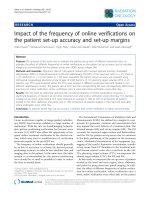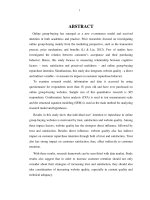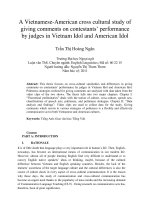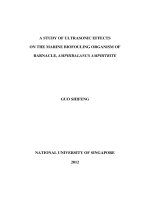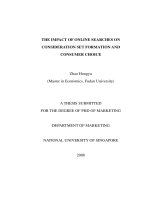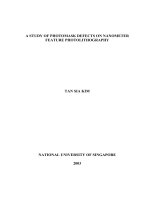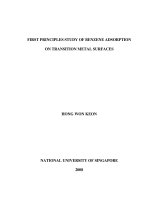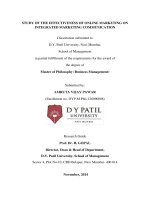Study Of The Effectiveness Of Online Marketing On Integrated Marketing Communication Amruta Pawar
Bạn đang xem bản rút gọn của tài liệu. Xem và tải ngay bản đầy đủ của tài liệu tại đây (2.94 MB, 197 trang )
STUDY OF THE EFFECTIVENESS OF ONLINE MARKETING ON
INTEGRATED MARKETING COMMUNICATION
Dissertation submitted to
D.Y. Patil University, Navi Mumbai,
School of Management
in partial fulfillment of the requirements for the award of
the degree of
Master of Philosophy (Business Management)
Submitted by:
AMRUTA VIJAY PAWAR
(Enrollment no. DYP-M.Phil-126090008)
Research Guide
Prof. Dr. R. GOPAL
Director, Dean & Head of Department,
D.Y. Patil University, School of Management
Sector 4, Plot No-10, CBD Belapur, Navi Mumbai- 400 614
November, 2014
STUDY OF THE
EFFECTIVENESS OF
ONLINE MARKETING ON
INTEGRATED
MARKETING
COMMUNICATION
i
DECLARATION
I hereby declare that the dissertation titled “Study Of The Effectiveness Of Online
Marketing On Integrated Marketing Communication” Submitted for the Award of
Master of Philosophy (M. Phil) in Business Management at D. Y. Patil University,
School of Management, Navi Mumbai; is my original work and the dissertation has
not formed the basis for the award of any degree, associateship, fellowship or any
other.
The material borrowed from similar titles other sources and incorporated in the
dissertation has been duly acknowledged.
I understand that I myself could be held responsible and accountable for plagiarism, if
any, detected later on.
The research papers published based on the research conducted out of the course of
the study are also based on the study and not borrowed from other sources.
Date:
Signature of the student
Enrollment no. DYP-M.Phil-126090008
ii
CERTIFICATE
This is to certify that the dissertation titled ―Study Of The Effectiveness Of Online
Marketing On Integrated Marketing Communication is the bona-fide research
work carried out by Ms. Amruta Vijay Pawar, student of M.Phil., at D.Y. Patil
University, School of Management, Navi Mumbai, in partial fulfillment of the
requirements for the award of the Degree of M. Phil. and that the dissertation has not
formed the basis for the award previously of any degree, diploma, associateship,
fellowship or any other similar title.
Place: Navi Mumbai
Date:
Signature of the HOD
Signature of Guide
Prof. Dr. R. Gopal
Prof. Dr. R. Gopal
iii
ACKNOWLEDGEMENT
I am thankful to D.Y. Patil University’s School of Management for giving me an
opportunity to pursue M Phil.
I would also like to thank my guide and my perpetual source of inspiration Prof. Dr.
R.Gopal for his valuable mentoring and inputs. His constant support and invaluable
advice has always guided me towards the right direction. He helped me to know
various phenomenons related to the research practices which further gave an impetus
to channelize my study in an appropriate way. I sincerely thank him for his treasured
guidance without which this dissertation would have never been possible.
I am also grateful to Dr. Madhukar Dalvi for helping me with his valuable guidance in
constructing software programs for my dissertation.
I won’t miss this opportunity to give credit to the sources both primary & secondary
for adding valuable inputs to my dissertation. I also thank the administrative staff, the
library staff & the computer lab staff of D.Y. Patil University, School of Management
for providing reference material required in my research work.
Lastly, I express my deep sense of gratitude to the almighty, my family, friends &
colleagues who have directly and indirectly helped me in this dissertation.
-------------------------Signature of Student
iv
TABLE OF CONTENTS
Chapter no. Chapter Name
Pg. no.
TITLE PAGE
I
DECLARATION
Ii
CERTIFICATE
Iii
ACKNOWLEDGEMENT
Iv
TABLE OF CONTENTS
V
LIST OF TABLES
Vi
LIST OF FIGURES
Viii
LIST OF ABBRIVIATION & ACRONYMS
EXECUTIVE SUMMARY
Ix
x – xxiv
1
Introduction to Integrated Marketing Communication
1
2
Introduction to Online Marketing
14
3
Literature Review
24
4
Research Objectives & Methodology
57
5
Conceptual Framework
65
6
Case studies on IMC & Online Marketing
93
7
Data Analysis & Interpretation
110
8
Conclusion, Recommendation & Limitations
158
Appendices
Appendix I
Bibliography & Webliography
Appendix II
Consent form with Questionnaire
1–7
v
LIST OF TABLES
Table
Description
Pg. no.
No.
7.1
Respondent’s profile
113
7.2
Do consumers rely on just one medium to get knowledge about
115
any brand?
7.3
Sources of awareness for various brands
117
7.4
Details for information and time spend to take purchase of any
119
commodity
7.5
Descriptive statistic scores for information and time spend to take
121
purchase of any commodity
7.6
Convergence with Internet
124
7.7
Frequency of being online
127
7.8
Descriptive statistic scores for convergent with the use of Internet
129
and frequency of being online
7.9
Purpose for using internet
131
7.10
Descriptive statistic scores Purpose for using internet
133
7.11
Do companies include online activities in their marketing
135
strategy?
7.12
Descriptive statistic scores for Use of online activities in their
137
marketing strategy
7.13
Importance of factors motivating respondents to like the brand on
141
internet
7.14
Descriptive statistic scores for Importance of factors motivating
143
respondents to like the brand on internet
7.15
Preference for the print ads or Television commercials
145
vi
7.16
Descriptive statistic scores for Preference for the print ads or
146
Television commercials
7.17
Benefits of online marketing over traditional marketing
149
7.18
Preference for Online advertising as it is SAFEST to use
152
7.19
Descriptive statistic scores for Preference for Online advertising
154
as it is SAFEST to use
7.20
Loopholes in online marketing over traditional marketing tools
155
vii
LIST OF FIGURES
Fig. No.
Description
Pg. no.
2.1
Top 20 countries with highest internet users
15
7.1
Graphical representation of Sources of awareness of various
118
brand
7.2
Graphical representation of Details for information and time
121
spend to take purchase of any commodity
7.3
Graphical representation of responses related to Knowledge of
126
the use of internet
7.4
Graphical representation of responses related to Frequency of
128
being online
7.5
Graphical representation of responses related to Use of online
136
activities by companies in their marketing efforts
7.6
Graphical representation of Preference for the print ads or
146
Television commercials
7.7
Graphical representation of Benefits of online marketing over
150
traditional marketing
7.8
Graphical representation of Preference for Online advertising as
153
it is SAFEST to use
7.9
Graphical representation of Loopholes in online marketing over
157
traditional marketing tools
viii
LIST OF ABBRIVIATIONS & ACRONYMS
IMC
:
Integrated Marketing Communication
WWW
:
World Wide Web
SEO
:
Search Engine Optimization
SEM
:
Search Engine Marketing
PR
:
Public Relations
SERP
:
Search Engine Result Pages
IP
:
Internet Protocol
PPC
:
Pay per Click
CPC
:
Click per Cost
CTR
:
Click through Rate
RSS
:
Really Simple Syndication
VM
:
Viral Marketing
WOM
:
Word of Mouth
SP
:
Sales Promotion
AIDA
:
Attention-Interest-Desire-Action
TA
:
Target audience
UGC
:
User Generated Content
ix
EXECUTIVE SUMMARY
Integrated Marketing Communication is a marketing concept that ensures all forms of
communication and messages are carefully linked together.
At its most basic level, Integrated Marketing Communication or IMC means
integrating all the promotional tools, so that they work together in harmony.
Promotion is one of the Ps in the marketing mix. Promotion has its own mix of
communication tools.
All of these communication tools work better if they work together in harmony rather
than in isolation. Their sum is greater than their parts - providing they speak
consistently with one voice all the time, every time.
Integrated Marketing Communication is the concept that makes all the marketing
tools to work together as a unified force rather than work in isolation. It makes the use
of entire marketing efforts in the form of advertising, public relation, personal selling,
sales promotion, internet marketing , direct marketing in order to generate maximum
impact on the target audience at the minimum cost.
According to William Stanton, “IMC is an element in organization’s marketing mix
that is used to inform, persuade and remind the market regarding the organization and
/ or its products.”
It blends various promotional tools and communication/marketing/advertising
services and techniques to maximize profit. IMC is ultimately achieved through
concise and consistent messaging that fosters familiarity and consumer affinity.
x
Effective IMC messages and images are meaningful and useful to consumers, and
messaging and branding consistency - a proven IMC concept - yield customer
satisfaction and loyalty.
Tools of IMC :
Advertising refers to "the means of providing the most persuasive possible selling
message to the right prospects at the lowest possible cost". Kotler and Armstrong
(2003), provide an alternative definition: "Advertising is any paid form of nonpersonal presentation and promotion of ideas, goods and services through mass media
such as newspapers, magazines, television or radio by an identified sponsor".
Sales Promotion is the Demand-stimulating activity designed to boost the sales of a
product or service. It may include an advertising campaign, increased PR activity, a
free-sample campaign, offering free gifts or trading stamps, arranging demonstrations
or exhibitions, setting up competitions with attractive prizes, temporary price
reductions, door-to-door calling, telemarketing, and personal letters on other methods.
More than any other element of the promotional mix, sales promotion is about action.
Public Relations programs are a planned communication effort by an organization to
contribute to generally favorable attitudes and opinions toward an organization and its
products. It is a communication function that seeks to build good relationships with
consumers, stockholders, and legislators. The advantages of publicity are low cost,
and credibility (particularly if the publicity is aired in between news stories like on
evening TV news casts). New technologies such as weblogs, web cameras, web
affiliates, and convergence (phone-camera posting of pictures and videos to websites)
are changing the cost structure.
xi
Personal Selling is oral communication with potential buyers of a product with the
intention of making a sale. The personal selling may focus initially on developing a
relationship with the potential buyer, but will always ultimately end with an attempt to
"close the sale. According to American Marketing Association, Personal selling is the
personal or impersonal process of assisting or persuading a prospective customer to
buy a product or service and to act favorable upon an idea that has commercial
significance to the seller.
Apart from the above, a new tool is being emerged in the contemporary
market scenario and that is named as online marketing.
Benefits of IMC:
Although Integrated Marketing Communication requires a lot of effort, it
delivers many benefits. It can create competitive advantage, boost sales and
profits, while saving money, time and stress.
IMC wraps communication around customers and helps them move through
the various stages of the buying process. The organization simultaneously
consolidates its image, develops a dialogue and nurtures its relationship with
customers. This 'Relationship Marketing' cements a bond of loyalty with
customers which can protect them from the inevitable onslaught of
competition. The ability to keep a customer for life is a powerful competitive
advantage.
IMC also increases profits through increased effectiveness. At its most basic
level, a unified message has more impact than a disjointed myriad of
messages. In a busy world, a consistent, consolidated and crystal clear
xii
message has a better chance of cutting through the 'noise' of over five hundred
commercial messages which bombard customers each and every day.
IMC can boost sales by stretching messages across several communication
tools to create more avenues for customers to become aware, aroused, an
ultimately, to make a purchase.
Carefully linked messages also help buyers by giving timely reminders,
updated information and special offers which, when presented in a planned
sequence, help them move comfortably through the stages of their buying
process and this reduces their 'misery of choice' in a complex and busy world.
IMC also makes messages more consistent and therefore more credible. This
reduces risk in the mind of the buyer which, in turn, shortens the search
process and helps to dictate the outcome of brand comparisons.
Un-integrated communication conveys disjointed messages which dilute the
impact of the message. This may also confuse, frustrate and arouse anxiety in
customers. On the other hand, integrated communication present a reassuring
sense of order.
Consistent images and relevant, useful, messages help nurture long term
relationships with customers. Here, customer databases can identify precisely
which customers need what information when and throughout their whole
buying life.
Finally, IMC saves money as it eliminates duplication in areas such as
graphics and photography since they can be shared and used in say,
advertising, exhibitions and sales literature. Agency fees are reduced by using
a single agency for all communication and even if there are several agencies,
time is saved when meetings bring all the agencies together - for briefings,
xiii
creative sessions, tactical or strategic planning. This reduces workload and
subsequent stress levels - one of the many benefits of IMC.
Limitations of IMC :
In addition to the usual resistance to change and the special problems of
communicating with a wide variety of target audiences, there are many other
obstacles which restrict IMC. These include: Functional Silos; Stifled
Creativity; Time Scale Conflicts and a lack of Management know-how.
Some organizational structures isolate communication, data, and even
managers from each other. For example the PR department often doesn't
report to marketing. The sales force rarely meets the advertising or sales
promotion people and so on.
And all of this can be aggravated by turf wars or internal power battles where
specific managers resist having some of their decisions (and budgets)
determined or even influenced by someone from another department. It
shouldn't matter whose creative idea it is, but often, it does. An advertising
agency may not be so enthusiastic about developing a creative idea generated
by, say, a PR or a direct marketing consultant.
IMC can restrict creativity. No more wild and wacky sales promotions unless
they fit into the overall marketing communication strategy. The joy of rampant
creativity may be stifled, but the creative challenge may be greater and
ultimately more satisfying when operating within a tighter, integrated, creative
brief.
A survey in 1995 revealed that most managers lack expertise in IMC. Not just
managers but also agencies. There is a proliferation of single discipline
xiv
agencies. There appear to be very few people who have real experience of all
the marketing communication disciplines. This lack of know how is then
compounded by a lack of commitment.
Understanding these limitations is the first step in successfully implementing IMC.
The advances in technology have led to one of the most dynamic and revolutionary
changes in the history of marketing, the dramatic changes in communication using
interactive media such as Internet. Interactive media allows communication on a two
way form instead of one way communication. And a two way communication plays
vital role in IMC.
Online marketing is becoming a hot topic in every business sector, and gradually
plays a truly important role in any company’s multi-channel marketing strategy.
It uses the Internet to deliver promotional marketing messages to consumers. It
includes email marketing, search engine marketing, social media marketing, many
types of display advertising (including web banner advertising), and mobile
advertising. Like other advertising media, online advertising frequently involves both
a publisher, who integrates advertisements into its online content, and an advertiser,
who provides the advertisements to be displayed on the publisher's content. Other
potential participants include advertising agencies that help generate and place the ad
copy, an ad server who technologically delivers the ad and tracks statistics, and
advertising affiliates who do independent promotional work for the advertiser.
xv
Tools of Online marketing :
Display advertising - Display advertising conveys its advertising message visually
using text, logos, animations, videos, photographs, or other graphics. Display
advertisers frequently target users with particular traits to increase the ads' effect.
Web banner advertising - Web banners or banner ads typically are graphical ads
displayed within a web page. Banner ads can use rich media to incorporate video,
audio, animations, buttons, forms, or other interactive elements using Java applets,
HTML5, Adobe Flash, and other programs.
Frame ad (traditional banner) - Frame ads were the first form of web banners. The
colloquial usage of "banner ads" often refers to traditional frame ads. Website
publishers incorporate frame ads by setting aside a particular space on the web page.
Pop-ups/pop-unders - A pop-up ad is displayed in a new web browser window that
opens above a website visitor's initial browser window. A pop-under ad opens a new
browser window under a website visitor's initial browser window.
Floating ad - A floating ad, or overlay ad, is a type of rich media advertisement that
appears superimposed over the requested website's content. Floating ads may
disappear or become less obtrusive after a preset time period.
Expanding ad - An expanding ad is a rich media frame ad that changes dimensions
upon a predefined condition, such as a preset amount of time a visitor spends on a
webpage, the user's click on the ad, or the user's mouse movement over the ad.
Expanding ads allow advertisers to fit more information into a restricted ad space.
xvi
Interstitial ad - An interstitial ad displays before a user can access requested content,
sometimes while the user is waiting for the content to load. Interstitial ads are a form
of interruption marketing.
Text ads - A text ad displays text-based hyperlinks. Text-based ads may display
separately from a web page's primary content, or they can be embedded by
hyperlinking individual words or phrases to advertiser's websites. Text ads may also
be delivered through email marketing or text message marketing.
Search Engine Marketing (SEM) - Search Engine Marketing, or SEM, is designed
to increase a website's visibility in search engine results pages (SERPs). Search
engines provide sponsored results and organic (non-sponsored) results based on a web
searcher's query. Search engines often employ visual cues to differentiate sponsored
results from organic results. Search engine marketing includes all of an advertiser's
actions to make a website's listing more prominent for topical keywords.
Search Engine Optimization (SEO) -Search Engine Optimization, or SEO, attempts
to improve a website's organic search rankings in SERPs by increasing the website
content's relevance to search terms. Search engines regularly update their algorithms
to penalize poor quality sites that try to game their rankings, making optimization a
moving target for advertisers. Many vendors offer SEO services.
Sponsored search - Sponsored search (also called sponsored links or search ads)
allows advertisers to be included in the sponsored results of a search for selected
keywords. Search ads are often sold via real-time auctions, where advertisers bid on
keywords.
xvii
Social media marketing - Social media marketing is commercial promotion
conducted through social media websites. Many companies promote their products by
posting frequent updates and providing special offers through their social media
profiles.
Mobile Advertising - Mobile advertising is ad copy delivered through wireless
mobile devices such as smartphones, feature phones, or tablet computers. Mobile
advertising may take the form of static or rich media display ads, SMS (Short
Message Service) or MMS (Multimedia Messaging Service) ads, mobile search ads,
advertising within mobile websites, or ads within mobile applications or games (such
as interstitial ads, “advergaming,” or application sponsorship).
Email Advertising - Email advertising is ad copy comprising an entire email or a
portion of an email message. Email marketing may be unsolicited, in which case the
sender may give the recipient an option to opt-out of future emails, or it may be sent
with the recipient's prior consent (opt-in).
Benefits of Online marketing :
Internet gives you a wide access of your potential customers. It has been
estimated that a couple of billion people around the world use the Internet, and
more are becoming aware of Internet with each passing day. So, marketing
your business to such a large group of people is only possible through Internet.
Internet is the only medium that is able to cross geographic and national
boundaries.
xviii
The cost of promoting your business on the Internet is cheaper than other
mediums of marketing. This makes it easy for small and mid-sized businesses
to advertise their products.
Internet allows the ability to stay connected with customers on a real-time
basis. If any discount going on, then it is easier to send an email to customers
and they can buy the product instantly. Internet also allows to send multiple
messages at the same time, which saves the tedious task of sending a
newsletter to every client.
Internet marketing facilitates an instant feedback from the customers.
Customers can share about their experience after using the product.
Internet marketing saves a lot of time and effort. Instead of having a customer
service representative to answer the queries of customers, one can put all the
information about the product or service on the Internet so that customers can
go through it. The most common way of doing it is to have a section dedicated
to frequently asked questions (FAQs) about the product so that customers get
all the required information about the product or the service.
Internet marketing allows your business to be available 24/7, which means
increased sales and profits.
Limitations of Online marketing :
Although, Internet marketing allows a wider reach, the start-up costs of a
website can be high. This includes the cost of the required software and
hardware, and maintenance costs.
There are still a lot of customers who use the Internet just for having more
information about a product and prefer to buy it in person. For example,
xix
Internet marketing allows a customer to view how a phone looks like and its
technical specifications, but customers prefer having a look at the phone in the
store to get a hands-on experience.
There are a lot of customers who are not proficient in using the Internet and
focusing solely on Internet marketing can cause you to lose these customers.
The rules of the trade change rapidly in Internet marketing, and it requires
constant attention and monitoring to ensure that your marketing strategy does
not look out-of-date.
The biggest disadvantage of Internet marketing is its vulnerability to
fraudulent activities. There are a lot of illegitimate websites out there which
look similar to original websites and rob the customers of their money.
Spamming is also one of the biggest challenges for Internet marketing and
confidential data can be easily stolen by hackers.
Internet marketing lacks the human touch that is involved when a customer
buys a product from a salesperson. This hampers the prospects of relationship
building which plays an important part in repeat sales and word-of mouth
publicity.
Internet marketing depends heavily on technology, which is vulnerable to
technical faults. For example, if a customer clicks on your advertisement but
due to a technical glitch, is unable to buy the product, he may easily become
irate and take his business somewhere else.
Although, there are some challenges involved in Internet marketing, it can be safely
said that Internet marketing has led to increased transparency and ease of buying
products. The need of the hour is to counter the challenges so that Internet marketing
proves to be truly beneficial for all.
xx
This dissertation aims at identifying the importance of integrated marketing
communication followed by the effectiveness of online marketing as a part of IMC
strategy. Therefore the objective of the research is to understand the massive
contribution of Online marketing as a part of Integrated Marketing Communication
and to know its splendid efforts towards promotion in practice and also to find out
some challenges in using online advertising as a tool of
Integrated Marketing
Communication. The research objectives are i.
To understand the importance of Integrated Marketing Communication.
ii.
To understand the importance of Online advertising in changing market
scenario.
iii.
To understand the reasons for growing popularity of online marketing.
iv.
To analyze the effectiveness of online marketing as compared to traditional
marketing tools.
v.
To identify the limitations of online marketing as IMC tool.
In order to attain these objectives, the methodology uses descriptive research design.
Data is collected from secondary as well as primary sources. Secondary data provides
necessary theoretical back up to the study which is collected from published or
unpublished sources. Primary data is collected under Survey method using
questionnaire as the main research instrument. Since “Customer`s inclination towards
Online marketing” is the core focus of the study, a structured & closed ended
questionnaire has been prepared for customers only.
The questionnaire incorporated questions related to customers’ preference for online
marketing and other traditional mediums for getting awareness on various brands and
making purchase decision. The questionnaire is then distributed among the sample
xxi
selected for this study. Stratified probability sampling is used with sample size as 200
within Mumbai suburbs and sample frame as educational institutions & corporate
offices.
Data collected is then analyzed with the help of statistical software SPSS 17.0 and
Ms-Excel Add-In Data Analysis. Statistical tools used for the analysis are Mean,
Median & mode, Standard deviation, Skewness & Kurtosis.
Statistical analysis of data put forward following conclusion –
Consumers reckon upon more than one medium to get knowledge of any
brand. Due to unlimited brand choices & price sensitivity, they undertake a
detailed evaluation of various brands by referring more number of sources of
information. So they may be using combination of various mediums such as
print ads, television commercials, in-store promotion to know about different
aspects of the brand.
Consumers do refer various mediums to get awareness but highest preference
is being given to the online media. Online media incorporates blogs, online
PR, Window displays, banner ads etc. And consumers today are more exposed
to these forms of online advertising as compared to advertising through other
mediums.
Consumers require more information to take purchase decision but they do not
like to spend much of their time for purchasing any commodity.
Consumers do require plenty of information to take purchase decision. This
information may increase their knowledge and assurance on brands’ attributes
& benefits consumers are likely to gain that will eliminate their confusion in
xxii
choosing any particular brand. Once they obtain the required information on
various brands, they take less time in the purchase of any commodity.
Consumers are well knowledgeable about various usage, functions and
benefits being offered by internet. The analysis reveals that there is high
degree of literacy for internet usage.
Due to its attribute of making life easier by allowing the users to have instant
access with every informational, educational, interactive & entertaining
material; Internet is heavily used medium today.
The most important activities to be done through internet are social
networking as it connects them with others, online shopping as it offers them
convenience of shopping and media sharing site as it allows them to download
their favorite enticing material such as songs, video, games etc.
Majority of consumers believe that companies should use online activities in
their marketing efforts. Since online activities facilitate good access and
higher reach to the customers; companies must take this advantage by
incorporating online advertising in their marketing strategy.
Consumers are motivated to use internet as it offers them products at
discounted rates, gives access to exclusive content such as specific functional
& emotional benefits of the brand, and allows them to give feedback about the
brand directly to the company.
Survey reveals that majority of consumers have stopped preferring television
commercials or print ads to get brand awareness. Thus the popular traditional
xxiii
mediums are no longer remained first preference for the consumers to receive
ad messages.
Consumers like interactive ability of online marketing which is not applied in
case of traditional mediums like print ads, television commercials or outdoor
media. Consumers like to exchange their views and share their feedback when
it comes to evaluating the brand or for taking purchase decision.
Though consumers are convinced with advantages of online activities majority
of them still feel that online marketing is not safe as there is more scope of
fraudulent activities followed by privacy issues. These may include cheating
customers by offering them faulty items, giving wrong demonstrations, taking
confidential information from them such as bank details, credit card details
and misusing the same.
It is therefore suggested that companies should not only rely on online marketing but
should incorporate it as a part of IMC strategy so that online marketing can have a
wider reach to the customers and its limitations will be repaired with the help of other
traditional tools. As these tools will help to create credibility and trust about the brand
among the consumers so there will be no question of susceptibility about those brands
being endorsed through online media.
The study is limited to Mumbai suburbs only but as a matter of future scope of the
study; it can be extended to the other states of country. This will help to know more
about the effectiveness of online marketing and its contribution in Integrated
Marketing Communication.
xxiv

